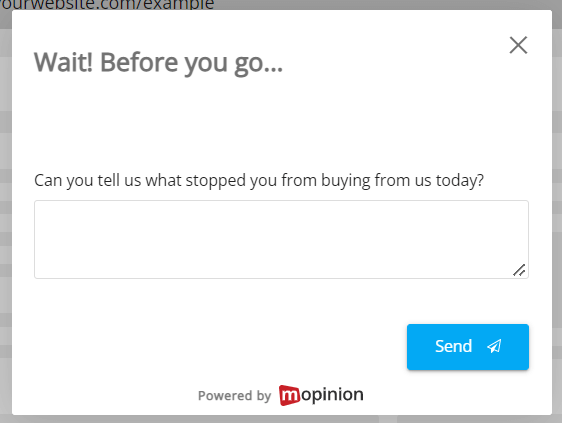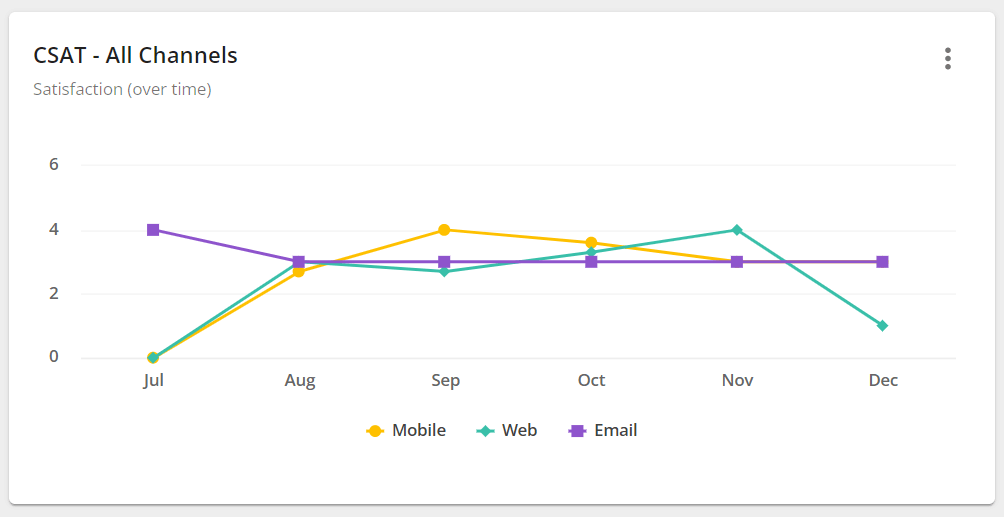Organisations nowadays have all of the data they need right at their fingertips. So why is it that some companies succeed and some struggle when it comes to the Voice of the Customer (VoC)? The answer to that is strategy. What those struggling organisations haven’t yet realised is that gathering VoC data is only half the battle. If there is no proper voice of the customer program in place that brings VoC data from insights to action, there’s really no sense in collecting it in the first place. In fact, if you look closely at leading VoC companies, you’ll see that they are the ones making the most of their feedback and putting it to action. In return, these same companies are rewarded with engaged customers and significantly better customer retention rates.
According to Gartner research,
Customer feedback can help decrease the cost of retaining those buyers – as companies that actively engage in a voice of customer programs, spend 25% less on customer retention than those that don’t.
So how exactly can you put your organisation on the path towards success when it comes to the voice of the customer?
To answer that question, let’s first explore what the voice of the customer actually is and why it’s important to your online success. Then we’ll dive into the steps involved in starting your own voice of the customer program.
What is the Voice of the Customer?
The Voice of the Customer is a research technique that maps out the detailed wishes and needs of your customers. Listening to the Voice of the Customer means listening to what your customers have to say about a product, service, or even online experience.
A well-rounded VoC program should include three different stages of feedback: Collection, Analysis and Taking Action. While many organisations only collect feedback, there is so much more to the process if you want to really understand your customers and provide real value for them. In other words, you should have a VoC software in place that not only collects VoC data, but also enables your team to analyse and act on the data you’ve collected.

Why is Voice of the Customer important?
Listening to the Voice of the Customer helps organisations transform their product or service into something that customers truly want and will continue to invest time and money into. And let’s be honest, it also serves up quite a few monetary benefits too such as:
- An increase in revenue: attributed to reduced churn and the ability to attract new customers.
- A reduction in costs: as a result of improving processes, which ensures compliance and creates more consistency.
But the best benefit of all is a VoC program’s ability to provide the organisation with the insights needed to make meaningful changes to the digital customer experience.
Practically speaking, an organisation will likely not see or experience their digital channels the same way their customers do. In fact, they probably experience their website, mobile app and/or email campaigns A LOT differently from customers and visitors, and that means they don’t always know if these channels are meeting their needs.
The result? An ‘experience gap’ materialises: an experience gap in how you expect or want your customers to experience your company and how they actually experience it. That’s why entering into a dialogue with your customers and/or visitors helps you to create a better digital customer experience. It also helps bring in new customers because it’s easier for them to achieve their goal online and thanks to the customer insights, you can better set your company apart from your competitors.
Do you find yourself in a similar situation? Then it’s time to kick start your voice of the customer program. Here’s how…
Starting your own Voice of the Customer program
Like any project, you’ll need to start with the basics: setting your goals and defining your objectives. Are there processes and/or strategies that need to be changed for the better? Then now is the time to tackle that.
By building your voice of the customer program around these issues, you can take a more goal-oriented approach to the process.
*And don’t fret, digital strategies change, so nothing has to be set in stone. You can always start with certain goals and reevaluate later, depending on the feedback you receive.
So once you’ve got your goals in place, it’s time to start gathering the data.

Source: Workday
Collecting Voice of the Customer data
In order to create positive change, you need to know how your customers are experiencing your digital channels and/or products and services. You can do this by collecting voice of the customer data (or user feedback) via voice of the customer surveys on your digital channels (i.e., websites, mobile apps and email campaigns).
How you do this is – of course – completely dependent on your strategy, the online journey of your customers, the digital channels you use, and many other factors.
Decide WHERE you’re going to collect VoC data
That being said, it’s probably easiest to focus on the concept of Moments of Truth (MoTs). Moments of Truth are crucial moments in which your customer forms an impression of your company or brand.
For an ecommerce organisation, these moments might include searching for products, search result pages, the actual purchase of a product and after-sales service (returns & delivery). Whereas for a financial institution, these moments are completely different, i.e., searching for information regarding policies, requesting quotes, or asking for advice on a certain service package.
These moments must be effortless for the customer and are, therefore, great opportunities to collect VoC data.
And then you must ask yourself: where are these moments taking place? Your digital channels are the face of your organisation and must therefore be in line with one another. Do you have a website and mobile app? Then the customer journey will need to be equally effortless on both channels, meaning you’ll want to gather website feedback and mobile feedback. Do you work heavily with email campaigns as a way of communicating with your customers? Then measuring email performance with email feedback should be a priority.
Learn more about collecting user feedback on these channels (including which metrics to use and when) here.
Decide HOW you’re going to collect VoC data
There are two different ways of collecting VoC data on your digital channels. Either passively via a feedback button located somewhere on the page or in-app or actively via behavioural triggers.
Let’s look at active feedback more closely, as this is the most effective.
For example – many ecommerce organisations leverage active VoC surveys throughout the online ordering funnel. Using certain behavioural triggers (i.e, leaving the browser, time on page, or clicking away from the shopping cart mid-purchase), these organisations can gather insights into why customers aren’t reaching their online goals in real-time.

Example of an active VoC survey
Additionally, many organisations gather feedback post-purchase or after a visitor has converted. This type of feedback gives the organisation insight into overall customer experience and customer loyalty levels.
Alternatively, if you are measuring email campaign performance, gathering feedback at the end of emails is the way to go. This data will help gauge what your audience thinks of your email and enable you to send them the right message.
Analysing Voice of the Customer data
Here’s generally where things go amiss. Your organisation has successfully collected voice of the customer data. You have crafted beautiful VoC surveys and strategically placed them across your digital channels, but that’s it. No follow up plan or way of analysing the incoming data to make it actionable. But this is one of the most crucial steps!
By analysing your data you can identify major breakthroughs for your organisation. For instance, you can leverage customisable dashboards that will help you visualise and identify trends that arise within your data. Alternatively, you can take advantage of text analytics and discover more about the sentiment and emotion behind your VoC data.
Just like VoC data collection, the analysis process should be carried out regularly as well. Real-time charts and dashboards make that possible.
However, the truth of the matter is, getting started with the analysis process can be a bit tricky and somewhat overwhelming for some organisations. Where do you start? How should you set up your dashboard for the best results? Which chart-building techniques will help you derive the most relevant insights from your data?
There are various ways in which you can organise your data depending on your goals with analysis.
For example, you can analyse trends in data overtime. Whether your organisation does this on a weekly, monthly, quarterly or annual basis, leveraging charts that measure these fluctuations will help you quickly detect changes in performance in a timely manner.

Additionally, you can bring different data sources (i.e. mobile, web and email VoC data) together to get a bird’s eye view of what is happening across your entire digital front.
And the list of options goes on. Learn more about how to get the most out of your VoC data analytics here.
Taking action on Voice of the Customer data
Lastly, to ensure the continuity and success of your voice of the customer program, you’ll need to consistently monitor your results and make improvements. Your VoC program should reflect the challenges and opportunities your business is faced with. Therefore, it needs to develop and grow alongside your company.
Taking action on your VoC data is essentially how you can ensure your customers and prospects ultimately buy from you and remain satisfied and loyal customers. Voice of the customer data is not only valuable for fixing online sales and service processes; it is also a great opportunity to convert an interested visitor into a customer and closing the loop is how you take the voice of the customer process full circle.
So what can you do to ensure this process is carried out effectively?
To start off, you’ll need to stay on top of your VoC data internally. There are several tools within VoC software that enable you to do so, including tagging, assigning feedback items to colleagues and even setting up alerts so that your VoC data is processed quickly. These tools help you distribute and manage this feedback across multiple departments.

Has the data reached all of the appropriate departments? Is the issue resolved and/or dealt with in some way or another? Then it’s time to revert back to your customers.
When it comes to digital channels, your customers generally want you to reach a resolution as quickly as possible, so it is advisable to bear this in mind internally. Track the progress of your actions and revert back to the customer to let them know their feedback is being processed and the team is working on a resolution. Upon resolution, be sure to notify the customer (or group of customers) depending on how widespread the issue is.
Learn more about closing the feedback loop here.
Time to hop on the VoC bandwagon, friends!
And there you have it! The recipe for a successful and long-lasting voice of the customer program. Now it’s up to you (and your VoC software) to make it happen. Don’t have a VoC software yet? Then be sure to select one that can bring your VoC program from insights to actions.
Mopinion is an all-in-one customer feedback tool that helps organisations collect and analyse website, mobile, and email campaign customer feedback. It has an easy-to-use interface, with which users can build, design and configure feedback forms however they like. Mopinion users can also target specific groups of visitors with feedback forms and gain insights into why they are struggling to convert. Once collected, feedback items can be visualised in customisable dashboards and charts for advanced analyses. Additionally, digital teams can share and take action on these feedback items in a timely manner with the help of smart alerts.
Ready to see Mopinion in action?
Want to learn more about Mopinion’s all-in-1 user feedback platform? Don’t be shy and take our software for a spin! Do you prefer it a bit more personal? Just book a demo. One of our feedback pro’s will guide you through the software and answer any questions you may have.






